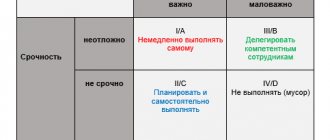Think back on your life over the past year. Do you feel like you have made significant progress in life? Can you say without a shadow of a doubt that you have grown as a person over the past year? Or, have you wasted important time on meaningless activities that lead you nowhere? Do you feel like you have no control over your life, spending your days in a rush? If you finally want to start the mechanism of your development, then write a personal development plan - this is an important thing that you must do.
You can write a plan any day, but as a rule, everyone has high hopes for the new year and expects changes. So why not finally start acting on the plan you made?
The power of having a clear plan is that you can guide all your actions in the right direction. Not only will this give you more control over your life, but it will also help you stop wasting your time.
The importance of creating a personal development plan
Do you know exactly where you want to be in the future? Can you answer in great detail where you see yourself in a year or even five years?
Most people have no idea where they are going. They let coincidence and luck decide their fate. They are all going somewhere, but most often it is a place where they neglect their own development. Don't be one of them! Don't let others decide for your life.
The importance of planning is carried out on several fronts. One advantage is that you will be faced with the rather difficult question of what your path is. This is an important issue that should not be overlooked. If you don't have a destination, it doesn't matter where you go. And if it doesn't matter which direction you move, you will eventually stop moving because lying down is more comfortable.
But once you start writing down what you want to achieve, you dramatically increase your chances of becoming who you want to be. Whenever you set carefully planned, realistic goals, you will always achieve what you want.
“Those who wrote down their goals achieved significantly more than those who did not write down goals.”
– Dr. Gail Matthews
The importance of planning has been backed by scientific research, which has shown that writing down your goals increases your chances of success.
Modern theories
Today, there are several theories that explain the concept of “personal growth”. Each of these teachings considers not only how a person moves along the path of forming an ideal “I”
Attention is also paid to factors that influence the effectiveness of self-development, as well as various prerequisites
A theory based on behaviorism states that every person has equal conditions from birth. According to this teaching, there are no innate talents or any uniqueness. These are individual traits acquired by an individual based on the conditions of his life and environment. This neutral approach is characteristic of Soviet psychology. At that time, it was believed that a person does not have any essence - he is born as a neutral subject, and the formation of his personality occurs due to the influence of society.
Proponents of existential theory believe that personal growth is possible only in the process of self-knowledge and self-development of the subject. The result of this work will be the achievement of a certain internal harmony, as a result of which the individual’s views on himself, his behavior and the world around him as a whole change.
Today, an increasing number of followers are appearing for the theory of inevitable or unconditional positivity. The main postulate of this teaching is the idea that from birth every person has unlimited potential. But its implementation becomes possible only under certain conditions.
Factors influencing personal growth, according to this theory, do not necessarily have to be positive. Positive personal development is possible under any conditions.
How to write a personal development plan?
The personal development planning process revolves around creating an action plan that is based on your ambitions for development in areas such as career and education, as well as self-improvement. Basically, a plan makes a statement about your future life and how you intend to achieve it.
Most people struggle when it comes to figuring out what exactly they should include in their personal development plan. Your plan should contain the following five criteria:
- What do you want (or where do you want to be)
- Why do you want it
- How do you plan to achieve this
- Potential Obstacles, Risks and Hazards
- How do you plan to overcome difficulties?
You can also include alternative plans that you can quickly arrange if things go wrong.
Try to thoroughly answer the following questions before developing your plan:
- What do I really want to make of my life?
- What kind of person is this that I really want to be?
- Do I have a vision of what I want to achieve in this world?
- What are my goals and ambitions?
- What are my dreams?
- Are my current decisions leading me to where I want to be?
Feedback
My team provided feedback on this tool.
It has both pros and cons. Pros of IPR:
- A convenient and effective practice that allows you to determine the goals necessary for individual growth and methods for achieving them.
- Constant monitoring makes it possible to evaluate acquired skills or, conversely, to pay attention to lagging areas.
- Self-education is very productively integrated into the work process.
- Allows you to evaluate where to move, which areas to pay attention to first, and they will be useful in your work.
- Allows you to avoid trying to optimize all metrics at once.
- With the selected materials, it is easier to move on to the actual study, because there is a list of specific books and courses.
- Partially answers the question “What do I even do?”
- It creates the feeling that you are not standing still, and you can even see what new things you have learned over the year.
Disadvantages of IPR:
- A situation may arise where there are no tasks for certain goals. Of course, even with independent projects, sometimes there are no current tasks to consolidate.
- It is not clear how to evaluate the items from the Soft skills section.
- Somehow it turned out that for the last two months we hardly met, which allowed us to forget about the plan. That is, I would like to emphasize the regularity of meetings.
conclusions
So, here are the basic recommendations for working with IPR:
- Have a plan—having a plan is better than not having one, and the team agrees.
- Distribute tasks taking into account the IPR.
- Create materials lists with your team and use them as a self-development tool.
- Use independent projects as an experimental platform for strengthening skills when current projects do not have such tasks.
useful links
- Programmer Competency Matrix.
- How to create a Skills Matrix for Success.
- Harvard Manage Mentor - Developing Employees.
- A framework for evaluating data scientist competency.
- Data Science Competency Matrix.
- T-shaped, Pi-shaped and Comb-shaped skills.
On May 25,
a two-week festival “Russian Internet Technologies” begins - everything to spur professional development. Here are a few master classes that will be useful to team leads and those who are planning to become one:
- Two-way interview: how to interview a company? / Anna Afonina, Vitaly Levchenko, Alexander Shvetsov.
- Tools for decomposing, planning and accepting tasks / Alexey Yagur (YouDo).
- Practices for developing personal effectiveness of a leader / Irina Shilova (SCOUT Academy).
And the selection of the program for the autumn Saint TeamLead Conf is proceeding as usual. If you want to speak, write. The sooner the better, because we are not waiting for a deadline to start accepting papers for the conference program.
Elements of a personal development plan
Planning is not difficult. The challenge, however, is creating a plan that actually reflects where you want to be and who you want to be. This also means that you will have to identify everything that will lead you closer to your goal.
Here's what you need to do to determine your individual development plan:
Making a list
Taking inventory may be the most difficult part of creating your personal development plan. It requires you to be honest with yourself and the situation in which you find yourself. Analyzing your current situation will help you identify areas you can work on in the future. This stage will also require you to reconsider your goals and ambitions.
Writing a mission
A personal statement can be useful for people who want to be able to evaluate the goals of their actions and activities. This statement helps you ask yourself whether what you are doing is contributing to your mission or not.
Short and long term planning
When developing a personal development plan, it is very important to divide it into short-term, medium-term and long-term parts. If you only plan for the long term, you are likely to ignore the importance of planning for the short term.
Re-evaluating your plan
Continuously re-evaluating your plan allows you to develop responses to recent events. This will help you come up with the best solution at the moment.
Taking and taking action
Why do you need a plan if you don't follow it? Make sure you don't forget your plan. Follow your plan and take the actions necessary to implement it.
Where to begin? Your first steps
Before you create a plan for self-development, you first need to carefully analyze your life now: all its aspects, from work to personal life. This analysis helps to identify all the “gaps” in your life, and, among other things, shows what needs to be changed in the near future. After such a “medical examination”, start drawing up your plan.
There is only one piece of advice here - a self-development plan is a purely individual thing, which the individual must draw up himself without anyone’s help. This does not mean that you cannot use individual fragments, but you should not copy it completely. Don’t forget, you adapt it to yourself, taking into account all the features of your character, as well as other traits of your personality.
When creating a self-development program for yourself, first of all, do not be afraid to experiment - decide on something new. It is not necessary to radically change everything at once, but it is necessary to build a gradual change. When creating a plan for personal self-development for the year, do not forget to also pay great attention to your creative development - this will make the abstinence period much easier for you, which will begin to appear some time after changing your behavior pattern.
Don't focus on one thing - develop comprehensively - let your knowledge deepen in different areas of activity with the same progress - this way you will have a significant advantage over other people.
Personal Development Plan Examples
The personal development plan can be divided into the following areas:
What do I want to achieve in life?
What is the true purpose of my life? The importance of knowing that you were born to do something should not be underestimated. This gives you the necessary foundation on which to build your plans for the future. However, discovering your life's purpose is a complex process that takes time.
What are my dreams? We all grew up with our wildest dreams, but as we got older, we lost sight of them and then forgot them completely. Don't make the mistake of rationalizing - dreams that inspire and motivate you are very important.
What kind of person do I really want to be?
What are my beliefs and values? Ask yourself what are the beliefs you hold and the values that are important to you.
Who am I now and who do I want to be in the future? Analyzing who you are now and who you want to become in the future will help you determine the direction of your work.
What are my goals?
Don't underestimate the importance of realistic and inspiring goals. It is advisable to divide these goals into short-term, medium-term and long-term. Short-term goals are those that take about six months to achieve. Medium term goals are approximately 1 to 3 years and long term goals are 5 years or more.
What are the necessary steps?
Many people only focus on setting ambitious goals without realizing the importance of specifying the necessary steps they must complete. Stages allow you to break a goal into several subgoals. This will allow you to maintain the necessary motivation even when you are working on long-term goals.
Other features no less important
Tactfulness is the ability to feel the emotions of other people, their state and mood. This trait allows you to either compliment a person or insult him. Tactfulness also needs to be learned by studying the psychology and characters of people.
Patience. One who has come a long way with small steps can become successful.
It is important to teach yourself to endure, even when difficult times come. Ingenuity is the quality of a true leader. It’s not enough to just find a way out of the situation; it’s important to think critically at all times
In this case, it is not necessary to create a new bicycle, but rather use available tools to facilitate the work process. Punctuality. A successful person is never late, which means that he is in control of his life: he follows a routine, has time to have breakfast, takes care of himself, leaves home earlier, is not distracted by extraneous matters, and clearly plans his day.
Qualities that will help you achieve success in life include independence (readiness to take a new path), courage, creativity (out-of-the-box thinking), independence (studying work processes and incorporating logic), will and your own opinion. All these traits will make you not only a rich person, but also a happy, worthy, respected one.
Man is a mechanical creature
Any human desire is the conscious mind, needs are the unconscious. Desires come from thinking, upbringing, imposed stereotypes. For example, I want a big house or to become president. For the sake of desire, you are ready to step over everything to get it, but in the end result, will you be happy? Do you know many happy people?
The unconscious does not know any desires, it is only interested in being fulfilled, in knowing peace and harmony within itself. Man lives in the illusion that he can do whatever he wants. In fact, a person is subject to two influences: the influence of the external environment and the influence of other people's thoughts and ideas. This controls our behavior and false desires.
In essence, it turns out that a person is a mechanical machine that is put into action, regardless of his will. We live in a world of illusions because it gives us pleasure, as if we can do something and are free to manage ourselves. This flatters our pride, elevates us, and we admire these illusions and want to believe in them. But in reality, a person does not know either himself or those around him. Common thoughts, views and public opinion create only a semblance, an illusion of knowledge about each other.
Thus, a person inadequately evaluates both himself and those around him. And everything happens against his will. Since man is a mechanical being, both small and large events only happen in his life. To the question: “How did you meet your soulmate?” - the majority answers: “Completely by accident! I ended up there and saw so-and-so.” And after that “accidentally” everything changes radically, life changes. And the person still continues to think that all this happened as if by itself.
4.Fighting fears - do what you are afraid of
Problems arise due to fears and the inability to deal with them. Some are afraid of meeting and communicating with new people, others are afraid of changing their usual way of life.
Important! Fears make life gray, boring and joyless. And most importantly, phobias are the main blocker to personal growth.
To get rid of fear, you need to kill it. This can only be done in one way: to do something that is scary. Dive headlong into fear rather than walk on the edge. Make it a rule to perform a heroic act every month, and your life will change for the better.
2. A look from the outside - discovering your own strengths and weaknesses
Thanks to technological progress, many new ways of self-improvement have emerged. You can use an ordinary camera on your computer, phone, camera, tablet and other gadgets. Take a picture of your usual day and take a look.
You can capture a separate important episode. For example, a business meeting, a conversation with a potential employer, communication with children or parents, etc. We need to focus on areas where there are tensions and failures.
All athletes use this method to improve their technique. They record themselves on video, watch and analyze. Mistakes made are more visible on the monitor screen than in real life. Especially when it comes to yourself.
The shortcomings of others sometimes seem so obvious. And sometimes their own people don’t even notice. A video chronicle of the day will show you your weak points. You will understand what you need to work on to move forward.











